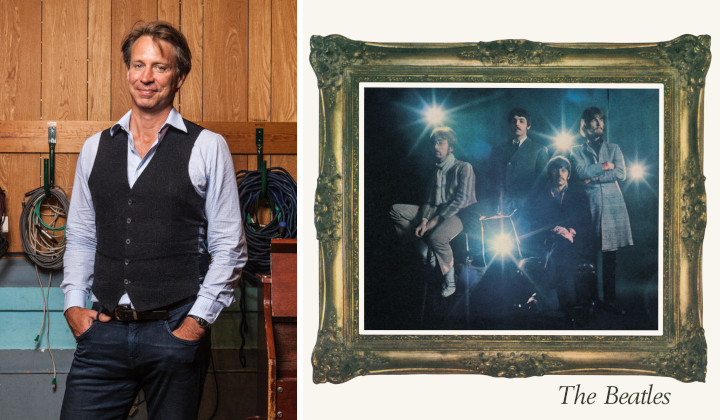Grammy Award-winning producer, songwriter, composer, and multi-instrumentalist Giles Martin recently joined Apple Music’s Zane Lowe for an in-depth conversation about how The Beatles’ iconic 1 album was translated to Spatial Audio for the first time.
He also talked about how the same treatment was applied to Strawberry Fields Forever in celebration of the song’s 55th anniversary.
In the conversation, Martin shared his unique insights and stories about the process of bringing immersive audio to a legendary body of work and honouring the legacy of his father and The Beatles.
He also shared his thoughts on how the new technology is transforming how music is created and enjoyed, its implications to a new generation of artists, and more.
In case you didn’t know, Giles Martin is the son of Beatles producer George Martin and originally, most of The Beatles’ original tracks were in mono.
They were later remastered in stereo as the technology became popular, but going from stereo to Spatial Audio is a quantum leap.
Ironically, Martin’s father did not encourage him to enter the music profession, but a young man surrounded by greatness at such a young age, could not but help to be influenced.
From The Interview With Zane Lowe
“My dad was, you know, was a futurist and loved technology… so he was always looking for a way of having great sound…,” said Martin about the evolution of sound.
He explains to Lowe how it all started when The Beatles and his father wanted to make imaginary worlds using music, with the Sgt. Pepper album and tracks like Tomorrow Never Knows and Revolver.
“These are things you can only imagine in John Lennon’s head. He tried to capture what was in the head and put on a record. And that’s the evolution of sound. It’s not just technology, it’s imagination as well and that’s key.” added Martin.
When asked about being given the responsibility to bring music from The Beatles to Spatial Audio, Martin said “I still find it hard to believe that I was given this responsibility. I never thought in my life I’d be mixing or remixing Beatles stuff.”
When asked why he did it, Martin answered: “Because they asked me to, and I don’t go do this work because, you know, I’m bored and there’s a cupboard of Beatles records I need to go look at.
He shared how Paul, Ringo, Olivia, Yoko, and the children of The Beatles, look after the legacy of the music while at the same time embracing technology and are willing to push it further.
But technology means nothing if it is not accessible.
Martin talks about his experience doing a show in Vegas in a space with 7,000 speakers, and how they made a record and it was successful. But it could not be enjoyed anywhere else.
Surround sound is still niche.
“It took like a company like Apple to work out how to make it a consumer experience on a grand scale, you know?” he added.
He believes that technologies like Spatial Audio are going to connect more people to music like never before.
So how long does it take to mix a hit song from The Beatles in Spatial Audio? It varies, recalled Martin.
It ranges from half a day to three days and beyond.
More than just remixing the tracks, he went to the studio where the music was originally recorded and captured the ambience of the room. All in the name of making the track feel right and putting the listener in the middle of it.
During the process, Martin says that Hard Day’s Night gave him a hard time because of how it was originally recorded, and A Day in the Life was a challenge because of how important the song is.
He says that most of the songs were recorded in limited tracks so separating the different instruments and placing them correctly to create that Spacial Audio just right was
Martin says that Strawberry Fields was his dad’s proudest work as a producer.
“John Lennon got in touch with him and they didn’t speak for a while for different reasons. John got in touch with him the month before he died. And my dad went to go see him in the Dakota building.
“And, John, you know, sort of —, they were thinking about working together again. And John said, “you know, I’d love to just go back and record everything again properly this time”. And my dad was like, “what??” And he goes “come on, we probably could do a lot better this time around.” My dad goes “what about Strawberry Fields?” and John went “especially Strawberry Fields” — so the legacy and the importance of that song for me personally is huge,” Martin admitted.
He expressed how a multitrack piece like Strawberry Fields is perfect for Spatial Audio and exclaimed how the immersive and the out of this world inducing music like it is the reason why Spatial Audio exists.

About Spatial Audio
In the simplest terms, Spatial Audio is a step above surround sound and the next evolution of Dolby Atmos.
With headphones or earbuds, Spatial Audio with dynamic head tracking not only makes it sound like you are surrounded by speakers but these speakers are stationary.
Think of it as virtual reality, but with sound.
With Spatial Audio, you can turn your head to face a particular sound or instrument and they will stay there, instead of moving with your head.
Spatial Audio works with not only music but movies and TV series.
Spatial Audio is available on iPhone, iPad, iPod touch, Mac, or Apple TV that is paired with AirPods Pro, AirPods Max, AirPods (3rd generation), or Beats Fit Pro.










